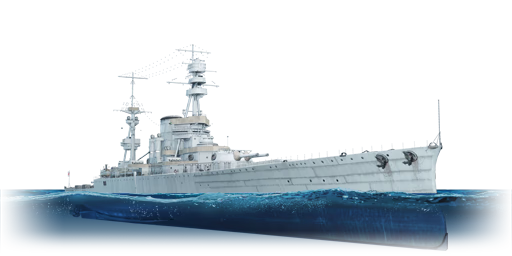



One of the trio of the Courageous-class "large light cruisers", the HMS Glorious's design perfectly encapsulates First Sea Lord John ('Jackie') Fisher's obsession with superior speed and firepower. Built with his 'Baltic Project' in mind, the ship was designed with high speed and large guns to devastate enemy cruisers while having a shallow draught to allow operations supporting coastal landings in the Baltics. Despite being a capital ship, it was designed with paper thin armour, partly to allow for the high speed and partly to get around a restriction imposed by the Government on the construction of new capital ships, with First Sea Lord Fisher presenting the ships as simply large light cruisers. In fact, the ships were so lightly built that the lead ship HMS Courageous took not insignificant structural damage in rough seas during sea trials, buckling the hull and deck in several places, shearing off rivets and allowing water to pour in.
As for the Glorious, she saw only a brief action in her "large light cruiser" configuration in the Second Battle of Heligoland Bight, where she was forced to retreat after a shell in her forward 15-inch turret prematurely detonated inside the barrel. After the Great war ended, such a specialized ship like the Couragous-class were deemed unnecessary, and all three of the Courageous-class were converted into aircraft carriers to make better use of the hull (and to avoid being scrapped altogether by restrictions imposed by the Washington Naval treaty). In her aircraft carrier configuration, HMS Glorious would go on to serve until the early stages of World War II. After being recalled from the hunt of the Admiral Graf Spee in 1940 to evacuate British aircraft from Norway, Glorious was intercepted and sunk by German battleships Scharnhorst and Gneisenau on 8 June 1940, with over 1,200 loss of lives.
Introduced in Update "Fire and Ice", the unconventional design of HMS Glorious in her 1919 configuration makes her very distinctive from the other "pocket battleships" at her BR, such as Graf Spee and the Ikoma. The ship is a true "glass cannon", featuring high offensive firepower in the form of four 381 mm cannons, numerous 102 mm guns, a huge stockpile of torpedoes, along with great mobility to boot, however still lacks adequate armour to shield from even cruiser-calibre guns.
| Ammunition | Type | Armor penetration (mm) at a distance: | |||||
|---|---|---|---|---|---|---|---|
| 1000 m | 2500 m | 5000 m | 7500 m | 10000 m | 15000 m | ||
| SAPCBC | 225 | 211 | 189 | 169 | 152 | 122 | |
| APCBC | 649 | 607 | 542 | 483 | 431 | 342 | |
| Ammunition | Type | Armor penetration (mm) at a distance: | |||||
|---|---|---|---|---|---|---|---|
| 1000 m | 2500 m | 5000 m | 7500 m | 10000 m | 15000 m | ||
| HE | 17 | 13 | 11 | 11 | 11 | 11 | |
| SAP | 87 | 66 | 42 | 28 | 20 | 18 | |
| Ammunition | Type | Armor penetration (mm) at a distance: | |||||
|---|---|---|---|---|---|---|---|
| 100 m | 1000 m | 2000 m | 3000 m | 4000 m | 5000 m | ||
| HE-TF | 11 | 9 | 8 | 7 | 7 | 7 | |











Seakeeping |
|---|
Unsinkability | |
|---|---|
Firepower | ||
|---|---|---|